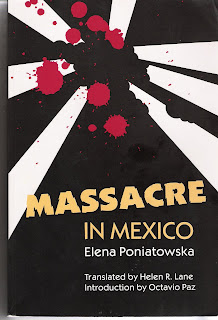
October 2, 2008 is the 40th anniversary of the massacre of Mexican students at the Plaza of the Three Cultures in Mexico City on October 2, 1968. This is known at the Tlatelolco Massacre.
In 1968 the summer Olympics were scheduled for Mexico City in October. Beginning in late July of that year there were a series of student demonstrations in Mexico City and the President Diaz Ordaz had responded with violence against the peaceful students. In August some 150,000 gathered in protest in the central square downtown, the Zocalo. Another demonstration was scheduled for the Plaza de Tlatelolco on the afternoon of October 2.
This site is known is known as the Plaza of the Three Cultures because there was an Aztec site here at the time of the conquest by the Europeans known as Tlatelolco. There is a colonial era church, San Francisco, that was built on the site. On this church there is a plaque with these words: "On August 13, 1521, heroically defended by Cuauhtemoc, Tlatelolco fell into the hands of Hernan Cortes. It was neither a triumph nor a defeat: it was the painful birth of the Mestizo nation that is Mexico today."

In the middle twentieth century a complex of bland modern architecture was built with apartments and Mexican Federal government offices. Thus, three cultures: Aztec, Colonial, and Modern.
At about 5:30 pm. on October 2 there was a crowd of some 10,000 or so demonstrators in the plaza and the military opened fire on them with automatic weapons. Some sources say from the ruins, others say from the upper floors of the modern structures. There may have been some confusion with the army firing on agents in the crowd on ground level. The demonstrators were unarmed. There were helicopters in the air and many were arrested and other demonstrators were killed. Some ran to the Church of San Francisco for safety. They were chased, beaten and some murdered.
The official government-offered death toll is 32. Other estimates are much higher.
The massacre quelled further demonstrations before the Olympics. However, according to Alan Riding in his 1985 book Distant Neighbors, "...the regime's response shattered the concept of rule by consensus and undermined the legitimacy of the entire system." (p.60) Some histories of Mexico divide history as before and after the Tlatelolco massacre. It is sometimes characterized as the "end of the revolution" which began in 1917.

I had read that a whole generation of middle class Mexican students were disillusioned by the massacre.
In August 1999 I took my daughter Taylor with me for a trip to Mexico City, after she had completed a year of High School that included instruction in Spanish. On August 3 we took one of those Gray Line tours that include Teotihuacan with the pyramids of the sun and the moon, the Basilica of the Virgin of Guadalupe and the Plaza of the Three Cultures.
When we were stopped at the Plaza of the Three Cultures in our little mini-bus I asked our middle-class bi-lingual guide, "Wasn't there a shooting here in 1968 involving students?"
"Shooting?" he replied. "It was a massacre!" He went on to tell us that he was then a young adult and was "in" it, and his cousin was wounded by the military. He also asserted that ovens at military installations were secretly burning bodies of students that had been transported from the scene at Tlatelolco. And our guide was a very straight guy.
This lends support in my mind to the assertion that there are many in Mexico disillusioned by the Tlatelolco Massacre.
During the regime of Vicente Fox there was an attempt to do a retrospective investigation of the events of 1968 and an evaluation of the role and culpability of President Diaz Ordaz. This fell far short of the hopes and expectations of those who had called for the investigation.
The most extensive coverage of the events of October 2, 1968 at Tlatelolco was done by the journalist Elena Poniatowska in the 1975 book pictured above. This is a series of interviews with many involved one way or another.
The top photo is the monument erected to the fallen students at Tlatelolco, with San Francisco Church in the background.
No comments:
Post a Comment